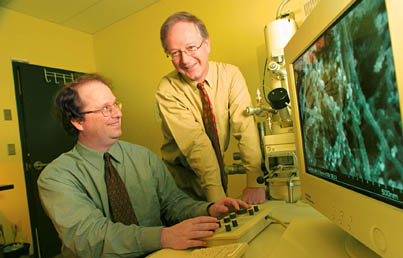It's a Nano World (Page 3)

Engineering nano experts Robin Drew and Raynald Gauvin.
Big Benefits from Tiny Technology
Carbon nanotubes are another favoured nano material. These filaments of carbon are several nanometres in diameter, with lengths reaching into the micrometre range. Discovered in 1991, their conductive properties make them extremely useful, as they can be used as "on-off" gates, a basic element in computer systems. They are also ten times stronger than steel, and Drew has collaborated with Raynald Gauvin, also in Mining, Metals and Materials Engineering, to explore their applications in magnesium and aluminum alloys for use in everything from automobile bumpers to airplane fuselages. So far, though, many of the challenges are very basic.
"One problem is to make nanotubes at a competitive price," says Gauvin. The current fabrication process involves plenty of waste carbon with a 0.2% nanotube output, a ratio Gauvin would like to see increased tenfold. "Then, we have to remove the nanotubes from the rest of the carbon and clean them of residue." Once extracted and spruced up, the nanotubes must be integrated into a metal to strengthen it - also no easy task. Still, if Drew and Gauvin are successful, their research could have profound consequences for industry in Quebec, which produces one-tenth of the world's aluminum, but ships most of it elsewhere for processing. "We have a strong aerospace industry in Montreal, and Bombardier airplanes are mostly aluminum," says Gauvin. "The economy will benefit if we could develop an industry fabricating aluminum with carbon nanotubes here."
Health care may also benefit from nano research. Calcium phosphate mineralization in the body can be desirable - we need it for bones and teeth - or detrimental, as it also is the process behind kidney stones and arterial sclerosis (the hardening of coronary arteries). The crystals formed by mineralization are two or three nanometres thick and a few dozen nanometres long, and their growth is controlled by segments of proteins, called peptides, which bind to their surface. "We're trying to understand how these organic proteins and inorganic crystals interact at the nano level," says Professor Marc McKee, who is cross-appointed in the Faculties of Medicine and Dentistry, where he is Associate Dean, Research. "Then we can try to cure mineral defects in the skeleton and teeth, and perhaps block crystal growth in pathologies like kidney stones."
Other research involves creating bioactive advanced materials like biochips, biosensors and other biomaterials which could be used for tissue replacement, such as with hip implants. Cells have patterns, tiny nanostructures, that are characteristic of them, and they can recognize these same patterns on other cells - a process known as bio-recognition. "It is possible to inscribe these nanostructure patterns from a cell onto a biomaterial's surface," says McKee. In effect, then, nanotechnology will allow scientists to create biomaterials whose surfaces mimic the body's cell structures. "Cells will recognize these patterns, which could then result in faster acceptance and smoother integration of the biomaterial into the body," he explains.


